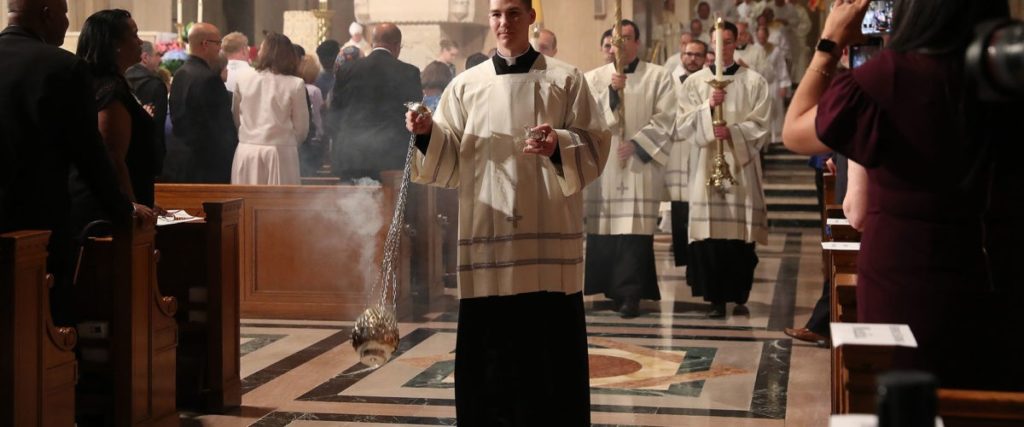Many readers of this column will know that in my religious practice I am by now something of a hybrid, attending both Catholic and Baptist churches every week when possible. This is time-consuming, for sure, but it does offer me access to developments in both these traditions. I want to tell you about something that I am noticing on the Catholic side.
Over the last few months, my wife, Jeanie, and I have visited Catholic churches in Highlands and Greensboro, N.C.; Macon, Ga.; and Chattanooga, Tenn. In each case, we have seen unmistakable signs of a conservative trend. Just bits and pieces of evidence, clues really, but I believe they add up to something.
In Highlands, after presiding over a very traditional form of the English Mass, the young priest announced he was heading off to a conference where he would take a leadership role in an event to be held entirely in Latin. He then went on to explain the benefits of using Latin, a language that does not evolve and therefore holds ancient doctrine firm and unchanging in a changing world. This statement was made just after Pope Francis restricted use of the so-called Traditional Latin Mass because it had become divisive.
In Greensboro on a recent visit, the invited guest celebrant was a 90-year-old Catholic priest whose personal mission in his retirement is to go around the country reinforcing the Catholic doctrine about use of natural family planning rather than technological means of birth control. He offered a forceful sermon on traditional Catholic sexual and family ethics and contrasted the church’s teaching with what he described as the moral chaos of modern society.
In Macon at a recent Mass, a young African priest officiated with passion and conviction and offered a sermon also focused on the vocation of marriage — and the need to stay married and not get divorced.
In Chattanooga last weekend, the forceful young priest presided over a large and bustling congregation filled with what appeared to be row after row of large young families. The young mothers generally wore head coverings, called mantillas. (This trend has been visible in all these congregations). There was an announcement about activities of the congregation’s homeschool co-op. And in his sermon the priest emphasized the week’s focus on the religious vocations, urging members to directly invite young people to consider whether they might be called to the religious life — that is, to become a priest, monk or nun.
I also noted in all the parishes the use of a kneeling rail for Communion, and the preference of the priests to give the Eucharist on the tongue rather than in the hand. I noted also that the altar was set up for the celebrants to face each other on both sides of the Communion table, and to preside from that angle, rather than facing the congregation directly. Did I mention heavy use of incense and chanted rather than spoken liturgy? Did I note that the altar attendants were all boys, and the priests were all young?
I grew up in a Vienna, Va., Catholic parish in the 1960s and early 1970s. I can attest that in that parish none of the things I just described would have happened. That was a congregation that (I now know) fully embraced the liturgical and doctrinal reforms of the Second Vatican Council (1962-1965). It was a modernized Catholic approach.
“It is possible to thumbnail the last 60 years of Catholic life as a sustained argument over whether Vatican II went too far.”
That approach always was disputed. Indeed, it is possible to thumbnail the last 60 years of Catholic life as a sustained argument over whether Vatican II went too far. I have been attending Catholic masses for decades since that time, and I have seen a variety of approaches. My parents’ parish in Front Royal, Va., for example, was and is very conservative. When I visited there a decade ago, I always thought the approach of that congregation, nestled in a red-state part of Virginia right around the corner from the ultra-conservative Christendom College (just think of that name!), was the anomaly among the nation’s Catholics. Now I am wondering if it was just a leading indicator of what was to come.
American culture is polarizing, we know this. American religion is polarizing right along with it. I have been catching a glimpse of red-state Catholicism. It is youthful, passionate and traditionalist. It is attracting young priests, and not just from other continents. It is attracting large young families. It has a robustness that many of our progressive Protestant churches can only long for at this time.
The challenge for progressive U.S. Christians of all stripes is to ask this: What must we do to be just as vital as these churches, but without the traditionalism? I think we have to offer a robust Christ-centered theological vision, with answers and not just questions, a powerful and cohesive community life, and an environment for children and young people that successfully transmits vital faith to the next generation.
This article first appeared on Baptist News Global

